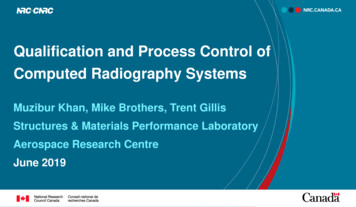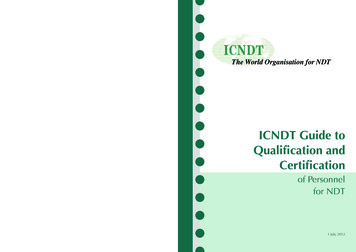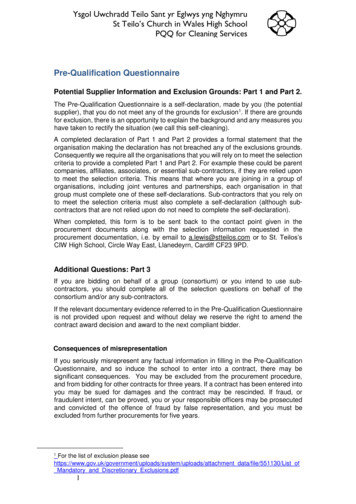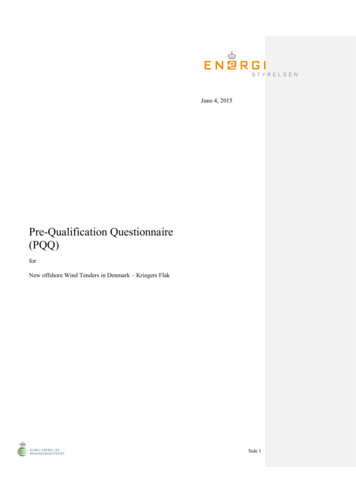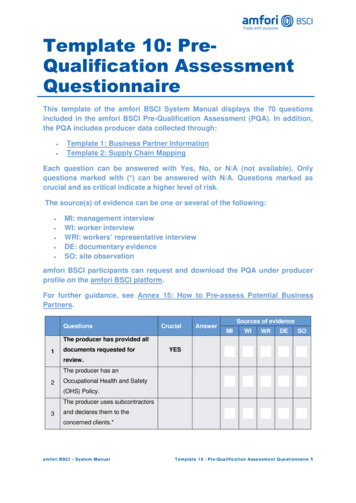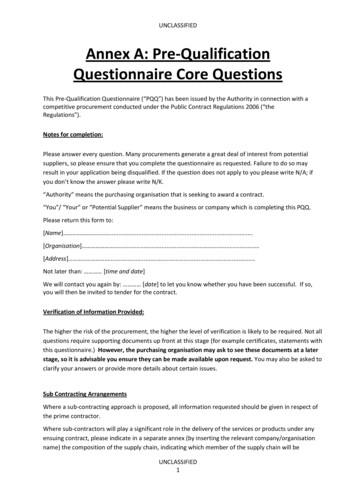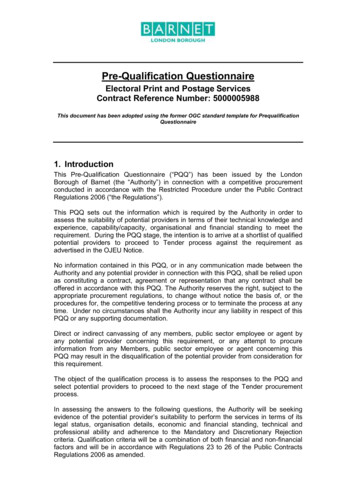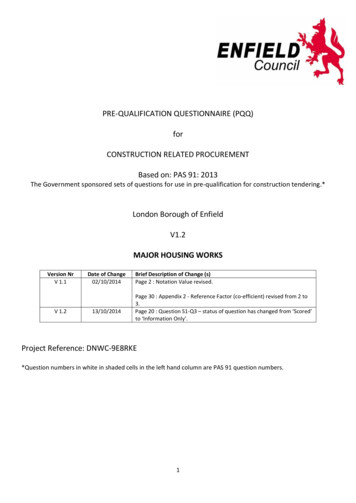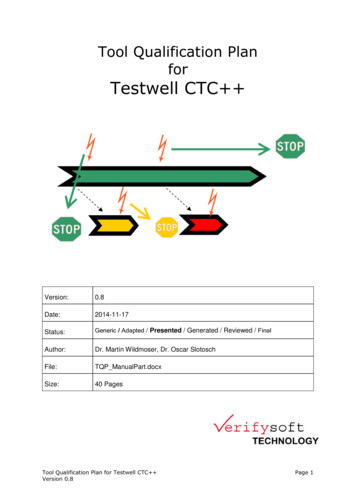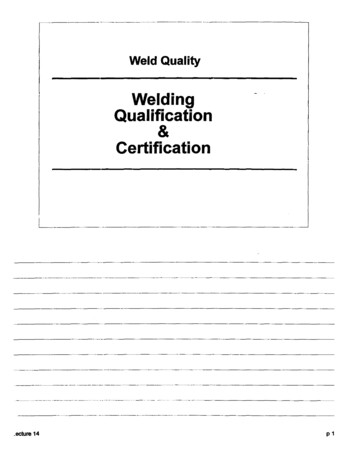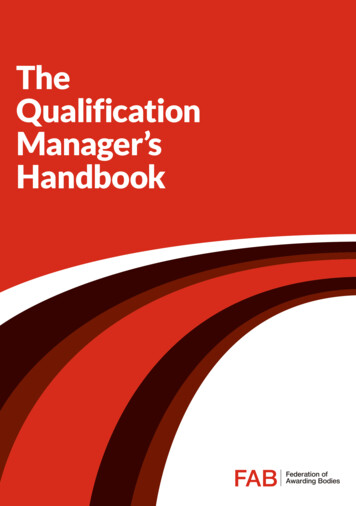
Transcription
TheQualificationManager’sHandbook
CEO’s forewordI am pleased to present the first edition of The Qualification Manager’s Handbookfrom the Federation of Awarding Bodies (FAB).This Qualification Manager’s Handbook provides practical information for people inassessment and awarding organisations, whether this is new information for those juststarting their career or a useful reminder for more experienced members of staff.The handbook includes an overview of the sector, an introduction to the key areas of thequalification lifecycle and insight into the range of topics and activities, including validity,in which a member of staff in an awarding organisation may engage.The handbook is part of a wider strategy to define the body of knowledge requiredto design and deliver high quality assessments and qualifications. This is an ongoingprogramme, encouraging debate and research, ensuring that new ideas are sharedthrough FAB as well as informing our training programme and of course futureeditions of the handbook. In an increasingly globalised qualification market, thereputation, dynamism and skills in the UK awarding sector puts us in a strongposition to play a leading role by encouraging and sharing new ideas, building ourreputation as thought leaders.Post-16 skills has suffered over many years because policy-makers have constantlyunderestimated the expertise needed to develop robust and valid technical andprofessional qualifications, often referencing inappropriate academic assessmentmethods. A more clearly articulated body of knowledge will challenge thismisconception, helping to inform more effective policies that deliver the resultsfor learners and employers that we all want to see.This handbook is a collaborative effort, but the main thanks go to Trisha Fettes whowrote the book, sharing her skills and knowledge as well as presenting all of our ideasin a coherent manner; also Prue Huddleston who chaired the editorial board as well asall those people involved with the development, scrutiny and production, including ourfriends at Policy Connect.This handbook is just the beginning, it is a living document – and I’d like to invite youto become part of the wider editorial team. We welcome your comments and feedback.Let’s work together on to make this a comprehensive, practical and well-thumbedresource for you and everyone in the sector.Email your thoughts and comments to swright@awarding.org.ukStephen WrightChief Executive, Federation of Awarding Bodies2
AcknowledgementsParticular thanks for contributions to this guide are due to:Stephen Wright who commissioned the handbookTrisha Fettes (lead writer)Karen Daws from FABBarry Smith and Steven Harper (co-authors)Professor Prue Huddleston, Chair of FAB’s Awarding Advisory Group (AAG)Paul Newton, OfqualNorman GealyDenise ClarkeGavin Busutti-Reynaud and colleagues from AlphaPlus Consultancy LtdDee ArpThanks go toRichard ChapmanPatrick CravenInga FitzgeraldDebra MalpassCathy O’ShaughnessyCharlotte PayneSusan James RellyRob RickettsLynn SeniorDebbie TuckwoodJonathan TummonsTracy TurvilleLouise Young
4
ContentsIntroductionPurpose of this handbook and structureOverview of the Awarding Sector679Chapter 1: So, You Want to Develop a Qualification1.1 Overview of the qualification lifecycle1.2 Managing your qualification’s lifecycle212225Chapter 2: Understanding Validity And Assessment2.1 What makes a qualification sufficiently valid2.2 Planning for validation2.3 Principles of assessment2.4 Forms of assessment4143505360Chapter 3: How To Design A Qualification3.1 Conduct market research and consultations3.2 Establish your qualification’s objective and target level3.3 Specify what your qualification will measure3.4 Identify your approach to assessment (strategy)3.5 Specify how your qualification will be assessed7173838998108Chapter 4: How To Develop A Qualification4.1 Shape the qualification and its progression4.2 Develop the assessment apparatus, including support materials4.3 Put it all together to inform delivery of your qualification111113121132Chapter 5: How To Deliver A Qualification5.1 Prepare for delivery of your qualification5.2 Provide support for qualification personnel and learners5.3 Understand what happens when candidates take assessments5.4 Maintain controls and security, deal with malpractice5.5 Evaluate candidates’ performance5.6 Report results, deal with appeals, award and certificate137139154163170180185Chapter 6: Qualification Review And Evaluation6.1 Prepare for review and evaluation6.2 Review the performance of your qualification6.3 Evaluate your qualification, including its validity6.4 Use data and findings189191193198207AppendicesA)Assessment methods – key featuresB)References and further information211211221
Introduction6
Purpose of this handbook and structurePurpose of the handbookThis handbook has been commissioned by the Federation of Awarding Bodies (FAB).FAB is a membership organisation which supports and represents the interests of UKvocational Awarding Organisations.The focus of the handbook is on regulated vocational qualifications. It does not set outto cover the particular requirements of general qualifications, such as Advanced GeneralCertificates of Education (GCE A Levels) and degrees, or unregulated qualifications,although some content may be relevant.It has been designed primarily for use by Qualification Managers who are new to theirpost. It may also be used as a handy source of reference for others with a specific interestin the development and management of vocational qualifications.How it is used will depend on your level of experience and the particular context(s) inwhich you work. The size and structure of your Awarding Organisation will determinethe range of your particular responsibilities.Whole books have been written on many of the subjects, for example, different forms ofassessment and theories that underpin them. It has not been possible, therefore, to coverthese in detail. The aim of the handbook is to provide insights into the range of topics andactivities in which Qualification Managers may engage. References are provided for youto explore in more depth, topics of particular interest.See Appendix B for further reading and FAB’s online library.Structure of the handbookFirstly, an overview of the UK Awarding Sector is offered to set the scene for subsequentchapters which outline key tasks and requirements for managing the lifecycle of aqualification.Chapter 2 broadly discusses validation and assessment, the understanding of whichis central to developing and delivering qualifications. Subsequent chapters cover eachlifecycle stage: how to design, develop, deliver, review and evaluate a qualification.Each chapter has a summary of key points and references to relevant support andpublications available through FAB. As qualification development is a creative and cyclicalprocess, at points in the text you may need to refer to other sections of the handbook.Where this may be helpful, clear signposts are provided, including use of arrows.Introduction7
Appendix A includes different methods of assessment.Appendix B provides references and details of key organisations in the UK concernedwith vocational qualifications including apprenticeships; and those supportinginternational work.The handbook reflects developments in the sector at the time of writing. However, thisworking environment is continually moving in response, for example, to governmentpolicy and market demands.It is acknowledged that many of the behaviours of Awarding Organisations will be drivenby qualification regulations and funding. But these are subject to change. Rather thanreplicate current regulations, this handbook tries to identify general principles and tasksthat are likely to have a longer shelf-life.This means, however, that you will need to keep abreast of developments as the sectorgrows and develops. You are encouraged to use the FAB website and weekly updates toassist in this.Access to updates via FABThe FAB website has a repository for resources and literature of relevance tothe vocational Awarding Sector, including that linked to each chapter of thishandbookThe website also includes notice of training events, meetings and webinars:http://www.awarding.org.uk/homeThe FAB Weekly update is the newsletter for FAB members. To access the latestissue, you need to login with your membership details. If you would like to jointhe mailing list, please email: enquiries@awarding.org.uk.See Appendix B for web links to qualification regulators, government departments andother organisations that provide updates.8Introduction
Overview of the Awarding SectorAwarding Organisations operate in a dynamic policy, regulatory and delivery landscapethat is subject to both market forces and changes in government policy. This can havean impact on: the types and design of qualifications; what drives education and trainingproviders that deliver qualifications; and who does what in the system.The Education and Skills sector, in which Awarding Organisations work, is diverse.For example, the range of providers include: Schools, colleges of further education and universities Public sector and private training providers Adult and community learning providers Employers of different sizes (those with internal training departments andthose without).The sector caters for learners of different ages, abilities, personal circumstances,experiences, motivations and aspirations. It employs teachers and trainers with differentbackgrounds, qualifications and varying experiences in industry and teaching expertise.There is a diversity of potential learning environments beyond the traditional classroom.Successive government reforms of vocational education and training have hadimplications, not only for the qualifications being developed, but for organisationsresponsible for their development, approval and quality assurance. For example,some reforms have led to the closure, merger or repositioning of some key organisations,and establishment of new bodies. In some cases, the competitive market has beenreduced through, for example, sole licensing arrangements. In other cases, marketsare opening up.See page 14 for a discussion of some of the challenges faced by Awarding Organisations.Introduction9
Some key organisations concernedwith qualificationsExamples of key organisations in England: The Department for Education (DfE) has overall responsibility for wholly,or partly, publicly-funded education, apprenticeships and skills. This includesapproving regulated qualifications for students under the age of 19 (Section96 of Learning and Skills Act, 20001) The DfE also sets the policy parameters within which the new Institute forApprenticeships operates. The Institute approves Apprenticeship AssessmentOrganisations. From 2018 it will manage Level 2 and 3 technical certificatesand maintain a register of Level 4 and 5 technical qualifications which areeligible for public subsidy through the Education and Skills Funding Agency The Education and Skills Funding Agency (ESFA), a DfE-sponsored executiveagency, is accountable for funding education and training for children, youngpeople and adults. It regulates academies, FE Colleges, employers and trainingproviders receiving public funding, and manages the Register of ApprovedApprentice Assessment Organisations2. The Office of Qualifications and Examinations Regulation (Ofqual)recognises Awarding Organisations that are required, or wish, to have theirnon-degree qualifications regulated.1 Section 96 of the Learning and Skills Act 2000 gives the Secretary of State power to approve qualifications suitable for delivery to young people aged lessthan 19 years old according to the following age categories: pre-16; 16-18; 18 . Public funding is considered for qualifications which have been section 96approved. Available at: ons2 The Register of Apprenticeship Assessment Organisations (RoAAOs) is a list of organisations that have been assessed as being suitable to conduct endpoint assessments of apprentices and be in receipt of public funds. Further information available at: on
Examples of key organisations in the devolved administrations: In Wales, the Welsh Government, through the Department for Education andSkills, has overall responsibility for qualifications policy and for determiningqualifications priorities in Wales Qualifications Wales, established through the Qualifications Wales Act 2015,regulates non-degree qualifications and the qualifications system in Wales.It is sponsored by the Welsh Government and accountable to the NationalAssembly for Wales, but is independent of government. A strategic authorityprovides regulatory oversight of post-compulsory education In Northern Ireland, the Department of Education is responsible for thecurriculum and assessment in schools and 14-19 policy. The Departmentfor the Economy is responsible for skills and employment, includingapprenticeships and further education. The Council for the Curriculum,Examinations and Assessment (CCEA) acts on their behalf on a day-to-daybasis, with its regulation arm (CCEA Regulation) regulating qualifications In Scotland, the Scottish Qualifications Authority (SQA) reports to theCabinet Secretary for Education and Skills who is also responsible for SkillsDevelopment Scotland (SDA). SDA supports people and businesses to developand apply their skills. SQA Accreditation regulates qualifications otherthan degrees, and approves and quality assures Awarding Bodies that offerqualifications in Scotland.SQA and CCEA both have awarding functions separate to their regulatoryresponsibilities.Sector Skills Councils and Sector Skills Bodies work with employers across the UKto define skills needs and standards in their industry, although their acti
This Qualification Manager’s Handbook provides practical information for people in assessment and awarding organisations, whether this is new information for those just starting their career or a useful reminder for more experienced members of staff. The handbook includes an overview of the sector, an introduction to the key areas of the qualification lifecycle and insight into the range of .
